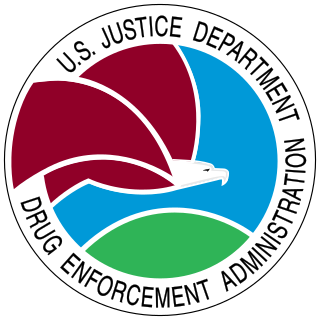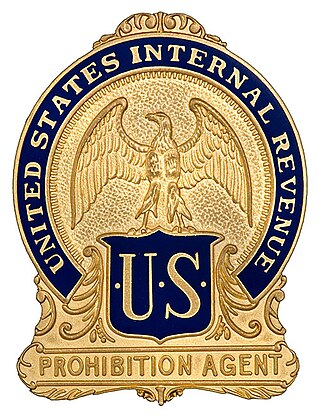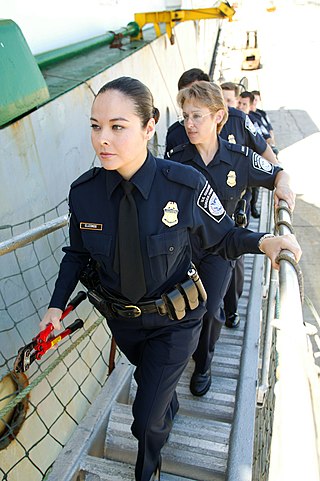
The United States Department of Justice (DOJ), also known as the Justice Department, is a federal executive department of the United States government tasked with the enforcement of federal law and administration of justice in the United States. It is equivalent to the justice or interior ministries of other countries. The department is headed by the U.S. attorney general, who reports directly to the president of the United States and is a member of the president's Cabinet. The current attorney general is Merrick Garland, who has served since March 2021.

The Drug Enforcement Administration (DEA) is a United States federal law enforcement agency under the U.S. Department of Justice tasked with combating illicit drug trafficking and distribution within the U.S. It is the lead agency for domestic enforcement of the Controlled Substances Act, sharing concurrent jurisdiction with the Federal Bureau of Investigation, the U.S. Immigration and Customs Enforcement, and U.S. Customs and Border Protection. However, the DEA has sole responsibility for coordinating and pursuing U.S. drug investigations both domestically and internationally.

The Bureau of Alcohol, Tobacco, Firearms and Explosives (BATFE), commonly referred to as the ATF, is a domestic law enforcement agency within the United States Department of Justice. Its responsibilities include the investigation and prevention of federal offenses involving the unlawful use, manufacture, and possession of firearms and explosives; acts of arson and bombings; and illegal trafficking and tax evasion of alcohol and tobacco products. The ATF also regulates via licensing the sale, possession, and transportation of firearms, ammunition, and explosives in interstate commerce. Many of the ATF's activities are carried out in conjunction with task forces made up of state and local law enforcement officers, such as Project Safe Neighborhoods. The ATF operates a unique fire research laboratory in Beltsville, Maryland, where full-scale mock-ups of criminal arson can be reconstructed. The ATF had 5,285 employees and an annual budget of almost $1.5 billion in 2021. The ATF has received criticism over its handling of the Ruby Ridge siege, the Waco siege and other incidents.

In the United States, a gun show is an event where promoters generally rent large public venues and then rent tables for display areas for dealers of guns and related items, and charge admission for buyers. The majority of guns for sale at gun shows are modern sporting firearms. Approximately 5,000 gun shows occur annually in the United States.

The Bureau of Prohibition was the United States federal law enforcement agency with the responsibility of investigating the possession, distribution, consumption, and trafficking of alcohol and alcoholic beverages in the United States of America during the Prohibition era. The enumerated enforcement powers of this organization were vested in the Volstead Act. Federal Prohibition Agents of the Bureau were commonly referred to by members of the public and the press of the day as "Prohis," or "Dry Agents." In the sparsely populated areas of the American west, agents were sometimes called "Prohibition Cowboys." At its peak, the Bureau employed 2,300 dry agents.

The United States Department of Justice Criminal Division is a federal agency of the United States Department of Justice that develops, enforces, and supervises the application of all federal criminal laws in the United States. Criminal Division attorneys prosecute many nationally significant cases and formulate and implement criminal enforcement policy. Division attorneys also provide advice and guidance to the Attorney General of the United States, the United States Congress, and the White House on matters of criminal law. The Division was founded in 1919.

The Organized Crime Drug Enforcement Task Force (OCDETF) is a federal drug enforcement program in the United States, overseen by the Attorney General and the Department of Justice. The principal mission of the OCDETF program is to identify, disrupt, and dismantle the major drug trafficking operations and tackle related crimes, such as money laundering, tax and weapon violations, and violent crime, and prosecute those primarily responsible for the nation's drug supply.

The United States Organized Crime Strike Force (Strike Forces) is a program of the United States Department of Justice Criminal Division empowering individual and coordinated units based in American cities across the country to pursue illegal racketeering by organized crime syndicates, including the Mafia, Gangs, the Irish Mob, the Russian mafia, and more. The Strike Forces have largely been eliminated since Attorney General Dick Thornburgh in 1989 merged the Strike Forces with the AUSAs, in what was called the "slow death" of the effort against organized crime. Other Strike Forces have been merged with the Strike Forces of the Organized Crime Drug Enforcement Task Force (OCDETF), losing the focus of racketeering to focus on drugs and narcotics.

The United States Department of Justice Antitrust Division is a division of the U.S. Department of Justice that enforces U.S. antitrust law. It has exclusive jurisdiction over U.S. federal criminal antitrust investigations and prosecutions. It also has jurisdiction over civil antitrust enforcement, which it shares with the Federal Trade Commission (FTC). The Antitrust Division often works jointly with the FTC to provide regulatory guidance to businesses.

The federal government of the United States empowers a wide range of federal law enforcement agencies to maintain law and public order related to matters affecting the country as a whole.
The United Blood Nation, also known as the East Coast Bloods, is a street and prison gang active primarily in the New York metropolitan area. It is the east coast faction of the California-based Bloods street gang. Their main source of income is the trafficking and sale of illegal drugs.
Strike Force may refer to:

The California Department of Justice is a statewide investigative law enforcement agency and legal department of the California executive branch under the elected leadership of the Attorney General of California (AG) which carries out complex criminal and civil investigations, prosecutions, and other legal services throughout the US State of California. The department is equivalent to the state bureaus of investigation in other states.
Project Gunrunner is a project of the U.S. Bureau of Alcohol, Tobacco, Firearms and Explosives (ATF) intended to stem the flow of firearms into Mexico, in an attempt to deprive the Mexican drug cartels of weapons.

eTrace is an Internet-based firearm trace request submission system, developed by the United States' federal government, Bureau of Alcohol, Tobacco, Firearms and Explosives, that provides for the electronic exchange of traced firearm data in a secure internet-based environment. Participating law enforcement agencies with access to the internet can acquire 24/7 real-time capabilities to electronically submit firearm trace requests, monitor the progress of traces, retrieve completed trace results, and to query firearm trace related data in Bureau of Alcohol, Tobacco, Firearms and Explosives (ATF) firearms registration database at the National Tracing Center. Firearms tracing is the systematic tracking of the movement of a firearm from its creation by the manufacturer or its introduction into U.S. commerce by the importer, through the distribution chain to the first retail purchase. Release 4.0, a bilingual version of eTrace was deployed in December, 2009 for the benefit of Spanish-speaking countries.

Gunwalking, or "letting guns walk", was a tactic used by the Arizona U.S. Attorney's Office and the Arizona Field Office of the United States Bureau of Alcohol, Tobacco, Firearms and Explosives (ATF), which ran a series of sting operations between 2006 and 2011 in the Tucson and Phoenix area where the ATF "purposely allowed licensed firearms dealers to sell weapons to illegal straw buyers, hoping to track the guns to Mexican drug cartel leaders and arrest them" - however as of October 2011, none of the targeted high-level cartel figures had been arrested. These operations were done under the umbrella of Project Gunrunner, a project intended to stem the flow of firearms into Mexico by interdicting straw purchasers and gun traffickers within the United States. The Jacob Chambers Case began in October 2009 and eventually became known in February 2010 as Operation Fast and Furious after agents discovered Chambers and the other suspects under investigation belonged to a car club.

The US federal government is an opponent of the illegal drug trade; however, state laws vary greatly and in some cases contradict federal laws.

Erin Nealy Cox is an American attorney who served as the United States Attorney for the United States District Court for the Northern District of Texas from 2017 to 2021. She was nominated to the position by President Donald Trump and confirmed by the U.S. Senate in 2017. After the 2020 election, she resigned effective January 9, 2021, and joined Kirkland & Ellis as a partner on June 23, 2021.

Daniel Chretien Comeaux is an American federal agent who currently serves as Special Agent in Charge (SAC) of the Drug Enforcement Administration's (DEA) Houston Field Division since 2021. Comeaux leads the DEA's efforts in 12 offices spanning 118,000 square miles across Texas, which encompasses over 16 million people.
Hanhong Pharmaceutical Technology Co. is a Chinese drug manufacturer. The company, its owner Du Changgen and some of its employees are indicted by the United States Justice Department for crimes relating to fentanyl, xylazine and methamphetamine production, distribution of synthetic opioids, and sales resulting from precursor chemicals. The indictments accuses Hanhong of exporting large quantities of fentanyl precursors and non-opioid additives like xylazine, to drug traffickers in Mexico and the United States. Its owner Du Changgen is the head of the Du Transnational Criminal Organization, which is listed on the United States Attorney General’s Consolidated Priority Organization Target (CPOT) list, which according to the DEA is a list of the leaders of the most prolific drug trafficking and money laundering organizations, having the greatest impact on the United States illicit drug supply.













